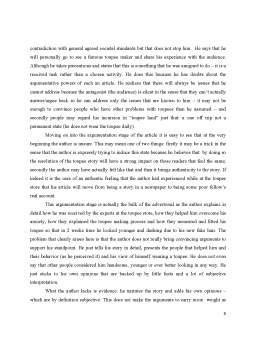Extras din referat
The object of my analysis is an advertorial that appeared in the 1960’s and presented a man’s vision on toupees. It is the story of how a journalist came to wear a toupee after being asked to write an article about this controversial subject at that time. You can find this advertorial attached at the end of this paper in Annex 1. I will show how the journalist came to change his own mind after covering this story for the newspaper he worked for, I will discuss and exemplify the dialectical stages of this advertorial, show evidence of strategic maneuvering and in the end I will try to look at the ten rules of the critical discussion and see if there are any fallacies present in this advertorial.
I considered this advertorial worth analyzing because the author had a personal stake in its creation in the sense that he starts off by being a skeptic and ends up a believer. So, I can assert that in this advert the audience (the people who are going to read the newspaper in which this advertorial featured) is the antagonist and the writer himself is the protagonist. The author starts out by agreeing with the audience that toupees are a bad idea, they are tasteless and almost always look fake. So, the initial standpoints of both the audience and the author are common. As the author goes on I could see that he starts to change his standpoint (and he gives his reasons) until he reaches a total opposite of his initial position. This is the way that the two parties are going to “play the game”: the author will declare that he now (after investigating) believes that toupees are a really good idea as he will introduce new information but as the audience still has to read this evidence they still stay on the opposite side. After the initial couple of lines the antagonist (the audience) is armed with the popular belief that toupees are bad while the protagonist (the author) armed with his own opinions gained from his incursion into the land of fake hair begs to differ.
It must be clear from this initial brief presentation that at least the first dialectical stage – the confrontation stage - is present in this advertorial. The two sides have silently established that they have a difference of opinion: toupees are bad/ toupees are good. In the next stage – the opening stage – the author establishes that he will bring proof of what he just stated by testing it out for himself. There is no need to state what the audience thinks as they all know it but he states it anyway just to ensure everybody that be realizes that what he is stating comes in contradiction with general agreed societal standards but that does not stop him. He says that he will personally go to see a famous toupee maker and share his experience with the audience. Although he takes precautions and states that this is something that he was assigned to do – it is a received task rather than a chosen activity. He does this because he has doubts about the argumentative powers of such an article. He realizes that there will always be issues that he cannot address because the antagonist (the audience) is silent in the sense that they can’t actually answer/argue back so he can address only the issues that are known to him – it may not be enough to convince people who have other problems with toupees than he assumed – and secondly people may regard his incursion in “toupee land” just that: a one off trip not a permanent state (he does not wear the toupee daily).
Moving on into the argumentation stage of the article it is easy to see that at the very beginning the author is unsure. This may mean one of two things: firstly it may be a trick in the sense that the author is expressly trying to induce this state because he believes that by doing so the resolution of the toupee story will have a strong impact on those readers that feel the same; secondly the author may have actually felt like that and then it brings authenticity to the story. If indeed it is the case of an authentic feeling that the author had experienced while at the toupee store that his article will move from being a story in a newspaper to being some poor fellow’s real account.
This argumentation stage is actually the bulk of the advertorial as the author explains in detail how he was received by the experts at the toupee store, how they helped him overcome his anxiety, how they explained the toupee making process and how they measured and fitted his toupee so that in 2 weeks time he looked younger and dashing due to his new fake hair. The problem that clearly arises here is that the author does not really bring convincing arguments to support his standpoint. He just tells his story in detail, presents the people that helped him and their behavior (as he perceived it) and his view of himself wearing a toupee. He does not even say that other people considered him handsome, younger or ever better looking in any way. He just sticks to his own opinions that are backed up by little facts and a lot of subjective interpretation.
Preview document
Conținut arhivă zip
- Teoria Argumentarii - Analiza Advertorial.doc












